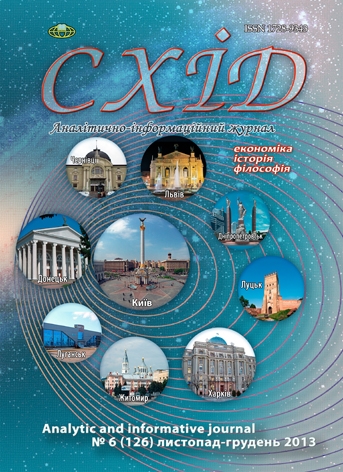Conceptual statutes of process of forming and development of human resource capacity of organization
DOI:
https://doi.org/10.21847/1728-9343.2013.6(126).20485Keywords:
human resource capacity of organization, management of human resource capacity, process of forming and development of human resource capacityAbstract
This paper deals with the features of managing the human resources formation and development іn organization. Author considers the evolution of "human resource management", "personnel management" and "management of human resource capacity" terms. The evolution of these terms is accompanied by the expansion of their content, due to organizational changes with the advent of globalization, internationalization and technological progress. The study examines the conceptual position of human resources management including foreign and domestic experience.
The paper determines the influence and relationship between organization goals and management of human resource formation and development. This paper shows the internal and external factors that influence on formation of human resource capacity.
The study determines the basic principles of human resource formation. Author defines the methods of human resource capacity development and basic guidelines of this process.
Downloads
References
Haslinda A. Evolving terms of human resource management and development / A. Haslinda // The Journal of International Social Research. - 2009. - Vol. 2 / 9. - Pр. 180 - 186.
Zorlu Senuycel. Managing the Human Resource in the 21st Century / Senuycel Zorlu. - Ventus Publishing ApS, 2009. - 77 р.
Prabhjot Kaur Mahal. HR practices as determinants of organizational commitment and employee retention / Kaur Mahal Prabhjot // The IUP Journal of Management Research. - 2012. - Vol. XI. - No. 4. - Pр. 37-53.
Безсмертна В. В. Стратегічне управління кадровим потенціалом підприємства / В. В. Безсмертна // Экономика и управление. - 2007. - № 3. - С. 48-53.
Hamdia Mudor. Conceptual framework on the relationship between human resource management practices, job satisfaction, and turnover / Hamdia Mudor, Phadett Tooksoon // Journal of Economics and Behavioral Studies. - February 2011. - Vol. 2, No. 2. - Pр. 41-49.
Кибанов А. Я. Управление персоналом организации / А. Я. Кибанов. - М. : ИНФРА-М, 2005. - 638 с.
Померанцева Е. Модели управления персоналом: исследования, разработка, внедрение / Е. Померанцева. - М. : Вершина, 2006. - 256 с.
Москаленко В. О. Основні принципи формування кадрового потенціалу підприємства [Електроний ресурс] / В. О. Москаленко // Науково-виробничий журнал Бізнес-Навігатор. - 2010. - № 3 (20). - Режим доступу : http://archive.nbuv.gov.ua/portal/soc_gum/biznes/2010_3/2010/03/100330.pdf.
Савченко В. А. Управління розвитком персоналу / В. А. Савченко. - К. : КНЕУ, 2002. - 351 с.
Балабанова Л. В. Управління персоналом / Л. В. Балабанова, О. В. Сардак. - К. : Центр навч. літ-ри, 2011. - 468 с.
Шкатула В. И. Настольная книга менеджера по кадрам / В. И. Шкатула. - М. : НОРМА-ИНФРА, 2008. - 307 с.
Грішнова О. А. Оцінювання персоналу: сучасні підходи до забезпечення ефективності / О. А. Грішнова, О. О. Наумова // Формування ринкової економіки : зб. наук. праць. - К. : КНЕУ, 2005. - Т. 2. Управління персоналом в організаціях. - С. 42-50.
REFERENCES
Haslinda A. (2009), Evolving terms of human resource management and development, The Journal of International Social Research. 2 (9), pp. 180-186 (engl).
Zorlu Senuycel (2009), Managing the Human Resource in the 21st Century, Ventus Publishing Ap, 77 р. (engl).
Prabhjot Kaur Mahal (2012), HR practices as determinants of organizational commitment and employee retention, The IUP Journal of Management Research, 4, pp. 37-53 (engl).
Bezsmertna V. V. (2007), Strategic human resources management company, Ekonomika i upravleniye, 3, pp. 48-53 (ukr).
Hamdia Mudor, Phadett Tooksoon (2011), Conceptual framework on the relationship between human resource management practices, job satisfaction, and turnover, Journal of Economics and Behavioral Studies, 2(2), pp. 41-49 (engl).
Kіbanov A. Ya. (2005), Management staff of the organization, YNFRA-M, Moscow, 638 p. (rus).
Pomerantseva E. (2006), Model of personnel management: research, development, implementation, Vershyna, Moscow, 256 p. (rus).
Moskalenko V. O. (2010), Basic principles of human resources of the company, Naukovo-vyrobnychyy zhurnal Biznes-Navihator, 3(20), available at: http://archive.nbuv.gov.ua/portal/soc_gum/biznes/2010_3/2010/03/100330.pdf (ukr).
Savchenko V. A. (2002), Management of staff development, KNEU, Kyiv, 351 p. (ukr).
Balabanova L. V., Sardak O. V. (2011), HR Management, Tsentr uchbovoi literatury, Kyiv, 468 p. (ukr).
Shkatula V. Y. (2008), Handbook of Human Resources Manager, NORMA-YNFRA, Moscow, 307 p. (rus).
Hrishnova O. A., Naumova О. О. (2005), Evaluation of staff: current approaches to performance, Formuvannia rynkovoi ekonomiky, Kyiv, Vol. 2, pp. 42-50 (ukr).
Downloads
Published
How to Cite
Issue
Section
License
Copyright (c) 2014 Viktoriia Hontiuk

This work is licensed under a Creative Commons Attribution-NonCommercial-NoDerivatives 4.0 International License.
1. Authors bear responsibility for the accuracy of facts, quotations, numbers and names used.
2. Manuscripts are not sent back.
3. The publisher does not always agree with the authors' opinion.
4. The authors reserve the right to authorship of the work and pass the first publication right of this work to the journal under the terms of a Creative Commons Attribution-NonCommercial-NoDerivatives 4.0 International License. This license allows others to distribute (copy) the published work for non-commercial purposes, provided there is mandatory attribution to its authors and a link to the first publication in our journal.
5. The authors have the right to conclude separate supplement agreements that relate to non-exclusive work distribution in the form in which it has been published by the journal (for example, to upload the work to the online storage of the journal or publish it as part of a monograph), provided that the reference to the first publication of the work in this journal is included.

